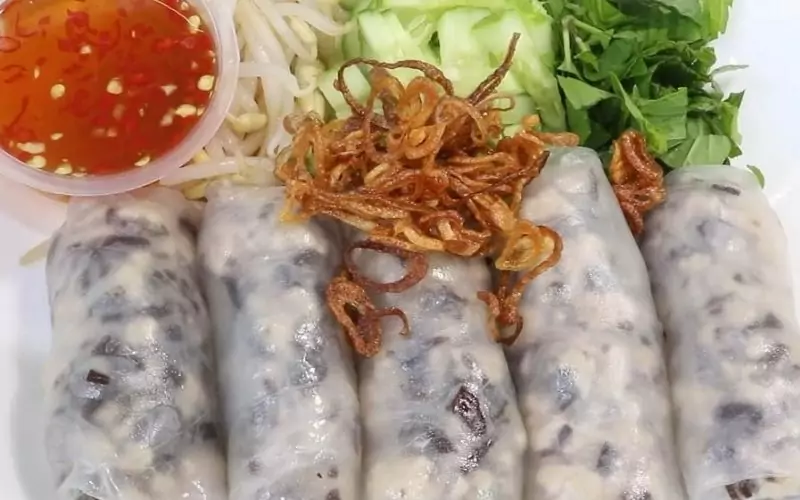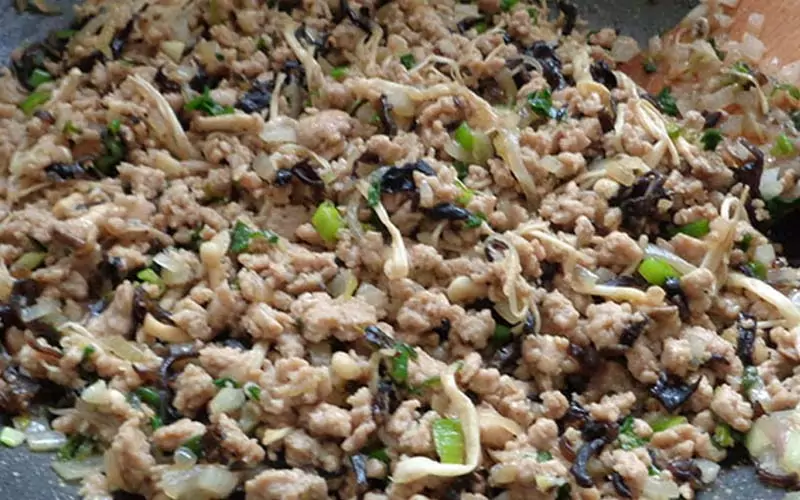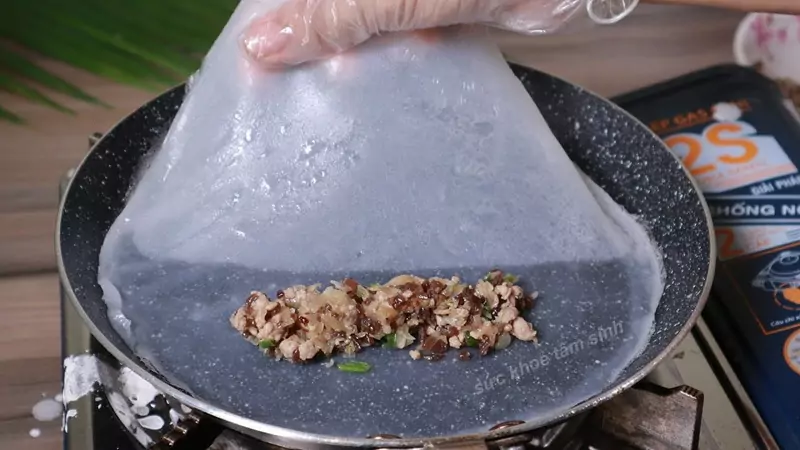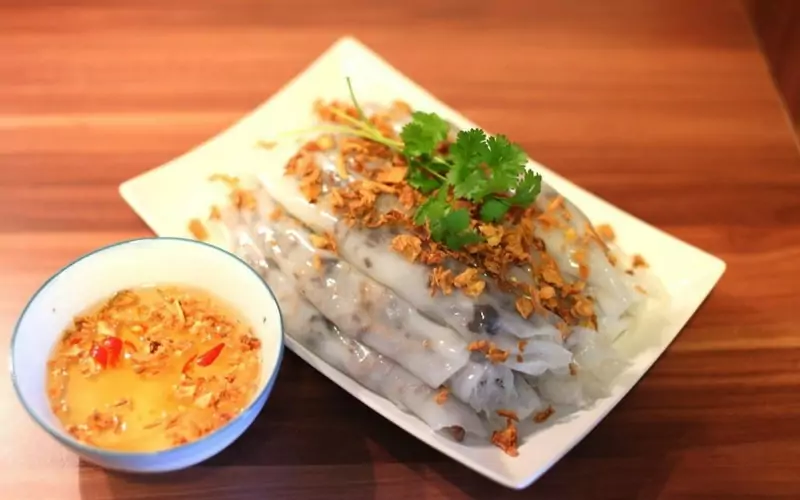Bánh cuốn (Vietnamese Steamed Rice Rolls), a quintessential Vietnamese dish, stands out despite its simplicity, captivating taste buds more than any other. The unlimited combination of accompaniments not only ensures a well-rounded nutritional profile but also enhances the dining experience. Learn the art of making bánh cuốn with the authentic Vietnamese recipe shared by Food Vietnamese in this article!
Emerging during the reign of the 18th Hung King, bánh cuốn has become a cherished breakfast staple across Vietnam. Its flavor is unassuming and familiar, yet remarkably unique and sophisticated. You don’t need to visit a restaurant to enjoy this delightful dish; you can effortlessly prepare bánh cuốn at home with a straightforward and quick method.
Nutritional Value of Vietnamese Bánh Cuốn
Bánh cuốn is a beloved staple in Vietnamese cuisine, primarily made from rice flour. It is typically enjoyed with accompaniments such as Vietnamese sausage (giò chả), grilled meat, fish sauce, and fresh greens. The dish is rich in carbohydrates, with each serving consisting of approximately 80% starch and 20% protein, sourced from the savory fillings and side dishes.

Culinary enthusiasts highly regard bánh cuốn as a delectable and nutritious breakfast choice that is easy to enjoy. Nowadays, this versatile dish can be savored at any time of the day, whether for breakfast, dinner, or a convenient snack. Consuming bánh cuốn provides the necessary energy for daily activities.
A 100-gram serving of bánh cuốn contains approximately 213 calories. Therefore, it is advisable not to consume it excessively to avoid weight gain. For those on a diet or following a low-carb regimen, it is recommended to enjoy bánh cuốn no more than three times a week, paired with plenty of fresh vegetables to help manage weight effectively.
Ingredients Needed to Make Bánh Cuốn
Rice Flour Mixture:
- 200g rice flour
- 40g tapioca starch
- 40g potato starch
- 1320ml water
- 1 teaspoon salt
- 3 tablespoons cooking oil
Banh cuon filling:
- 15g dried wood ear mushrooms
- Hot water (for soaking mushrooms)
- 2 tablespoons cooking oil
- 127g onion, peeled and finely chopped
- 300g ground pork
- 1 teaspoon salt
- 1/2 teaspoon MSG
- 1 teaspoon ground black pepper
- 29g scallions
- 172g jicama, peeled and finely chopped

Vegetables and dipping sauce
- 1 cucumber
- Blanched bean sprouts
- Vietnamese sausage (chả lụa)
- Sweet and sour fish sauce
Instructions for Making Vietnamese Bánh Cuốn
Steps for Preparing the Rice Batter:
- Combine all the rice batter ingredients in a large bowl and mix well.
- Let the mixture rest for 8 hours or overnight.
- Gently skim off the water on top without disturbing the settled flour at the bottom. Do not stir the batter.
Steps for Preparing the Filling:
- Soak dried wood ear mushrooms in hot water until they expand, about 30 minutes. Rinse and finely chop them.
- Peel and finely chop the onion.
- Squeeze the finely chopped jicama to remove as much water as possible.
- Mince the pork.
- Place each ingredient into separate small bowls.
- Heat a pan over low heat, add oil, and sauté the onion until lightly golden.
- Add the minced pork, MSG, salt, and pepper. Cook over medium heat, breaking up the pork to ensure even cooking and to prevent clumping.
- When the pork is about 80% cooked, add the chopped jicama and cook until most of the liquid evaporates, which takes a few minutes. Add the mushrooms and cook for another 2-3 minutes to keep them crunchy.
- Stir in the scallions, turn off the heat, mix well, and adjust the seasoning to taste.

How to Steam Bánh Cuốn
- Prepare a steamer pan, pour water below, and stretch cloth over the top of the pan.
- Before steaming the bánh cuốn, add a bit of salt to the batter mixture and stir well.
- Place the steamer on the stove, fill it with water up to two-thirds, and bring to a boil over high heat.
- Before each steaming, stir the batter with a ladle to mix the flour and water evenly, then scoop and pour a thin layer of batter onto the steaming cloth, spreading it quickly. If the cloth is not fully stretched, the batter may pool in the center, so pay close attention. If the ladle starts sticking to the cloth, it means you have taken too long to spread the batter.
- Cover the steamer and steam for about 40 seconds. Check if the bánh cuốn is done by looking for bubbles forming on the cloth surface and the batter becoming more translucent without the opaque white color.
- Use a thin stick or a chopstick to lift the bánh cuốn from left to right. You can adjust the batter consistency with each batch. If the batter is too thick, add 1-2 tablespoons of water; if too thin, add 1 tablespoon of rice flour. Batter that is too thick and dense will be difficult to spread and remove from the cloth.
- Place the steamed bánh cuốn on a plate greased with cooking oil, add 1 teaspoon of filling, and fold it into a roll.
Finished Product
Arrange the bánh cuốn on a plate, sprinkle with crispy fried shallots, add finely chopped cucumber, and place slices of Vietnamese sausage (chả lụa) on top. Add bean sprouts and fresh herbs to enhance the dish’s flavor. When enjoying, dip the bánh cuốn in sweet and sour fish sauce. The translucent, tender bánh cuốn with fragrant, savory minced pork filling inside will leave you wanting more.

